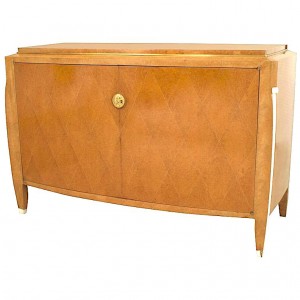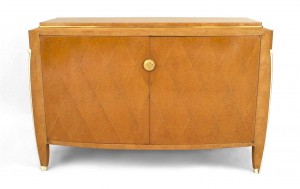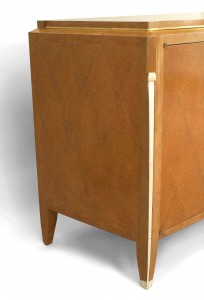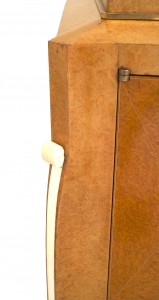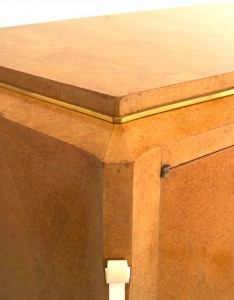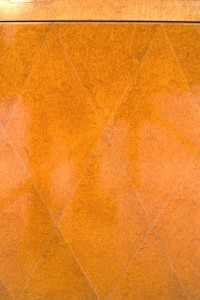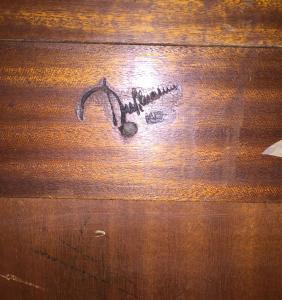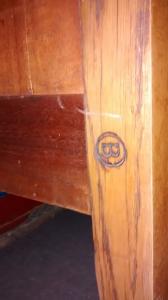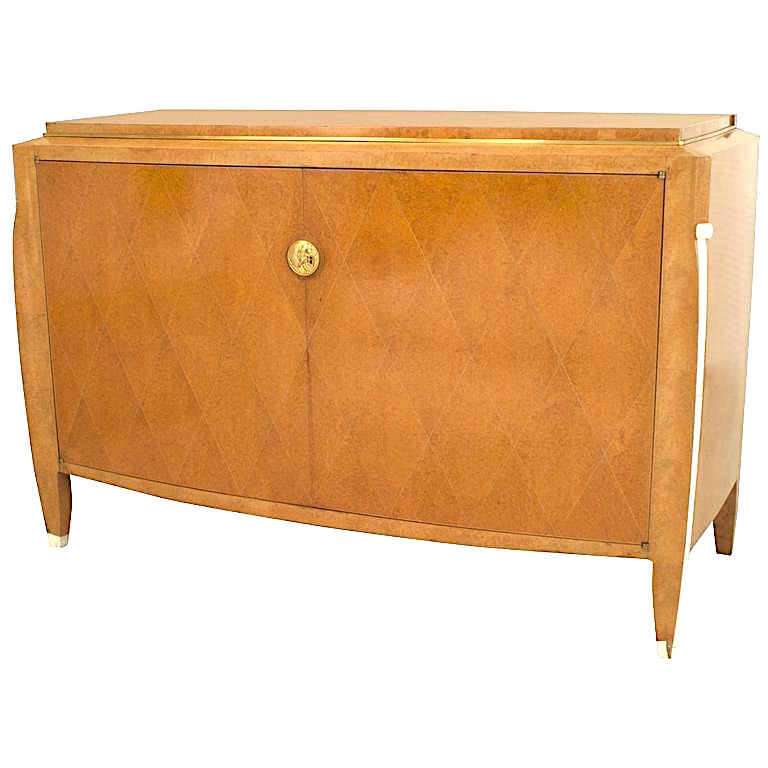French Art Deco Burled Amboyna Commode
$215,000 (USD)
Qty: 1 (On Hold)
Item #: 060559
French Art Deco burled amboyna wood two door commode with bronze trim detailing with diamond design brass pencil line inlay. (Rasson model) (signed: EMILE-JACQUES RUHLMANN) NOTE: IVORY TRIM HAS BEEN REPLACED.
Ships from:
Newel Gallery
306 East 61st Street, 3rd Floor
NY - 10065
Taxes may apply.
Learn more
See it in Person
Call (212) 758-1970 or Email Us
French Art Deco Burled Amboyna Commode
Need Assistance?
Call us at 212-758-1970 for assistance With made to order items
Special Order Terms & Conditions
50% due on approval. 50% upon completion Of production. Please refer to Newel's company policies
INQUIRE
PLEASE FILL IN THE REQUIRED FIELDS.
X
French Art Deco Burled Amboyna Commode
French Art Deco burled amboyna wood two door commode with bronze trim detailing with diamond design brass pencil line inlay. (Rasson model) (signed: EMILE-JACQUES RUHLMANN) NOTE: IVORY TRIM HAS BEEN REPLACED
DETAILS
Sku:
060559
Ships From:
New York, NY
Creator:
Emile-Jacques Ruhlmann
DIMENSIONS (INCHES)
Width:
56.3"
Height:
36.5"
Depth :
23.3"
INFO
Style:
Art Deco
Materials & Techniques:
Amboyna, brass, bronze, burl, inlay, wood
Category:
Tables, Cabinets & Case Goods, Dining Room

About Emile-Jacques Ruhlmann
Emile-Jacques Ruhlmann (August 28, 1879 – November 15, 1933) was a renowned French furniture designer and interior decorator. He is widely regarded as one of the most influential figures in the Art Deco movement.
Born in Paris, France, Ruhlmann came from a family of furniture manufacturers. He initially joined the family business, but his passion for design led him to establish his own workshop in 1907. Ruhlmann quickly gained recognition for his exceptional craftsmanship and innovative approach to furniture design.
Ruhlmann's work was characterized by its luxurious and refined aesthetic, combining traditional craftsmanship with modern materials and techniques. He drew inspiration from a variety of sources, including the Art Nouveau movement, Japanese art, and Read Full Bio
Emile-Jacques Ruhlmann (August 28, 1879 – November 15, 1933) was a renowned French furniture designer and interior decorator. He is widely regarded as one of the most influential figures in the Art Deco movement.
Born in Paris, France, Ruhlmann came from a family of furniture manufacturers. He initially joined the family business, but his passion for design led him to establish his own workshop in 1907. Ruhlmann quickly gained recognition for his exceptional craftsmanship and innovative approach to furniture design.
Ruhlmann's work was characterized by its luxurious and refined aesthetic, combining traditional craftsmanship with modern materials and techniques. He drew inspiration from a variety of sources, including the Art Nouveau movement, Japanese art, and the decorative styles of the 18th century. His designs often featured exotic woods, intricate marquetry, and exquisite detailing.
In addition to furniture, Ruhlmann also created complete interior schemes for prestigious clients, including wealthy industrialists and members of the French aristocracy. His interiors were known for their harmonious color palettes, elegant proportions, and meticulous attention to detail. Ruhlmann's ability to create cohesive and visually stunning spaces made him a sought-after designer during the height of the Art Deco era.
Ruhlmann's career reached its peak in the 1920s and early 1930s, when he collaborated with other prominent designers and artists of the time. He worked closely with renowned sculptor Jean Dunand, who created exquisite lacquer panels for Ruhlmann's furniture pieces. Ruhlmann's designs were also showcased in various international exhibitions, further solidifying his reputation as a leading figure in the field of decorative arts.
Tragically, Ruhlmann's prolific career was cut short when he passed away in 1933 at the age of 54. However, his legacy continues to inspire contemporary furniture designers and collectors alike. His pieces are highly sought after and can be found in prestigious museums and private collections around the world.
Emile-Jacques Ruhlmann's contributions to the field of furniture design and interior decoration have left an indelible mark on the history of design. His ability to seamlessly blend traditional craftsmanship with modern sensibilities has made him an enduring icon of the Art Deco movement.
more works by Emile-Jacques Ruhlmann
French Art Deco Burled Amboyna Commode
$215,000
(USD)
QTY: 1
#060559
Width: 56.25"
Depth: 23.25"
Height: 36.5"
Save to project
related items
Pair of Art Deco French Rosewood Commodes with Bronze and Ebonized Trim
$9,600
/ Each (USD)
QTY: 2
#063556
Width: 24.75"
Depth: 14.25"
Height: 23"
Save to project
French Art Deco Dufrene Mahogany & Marble Commode
$47,500
(USD)
QTY: 1
#057681
Width: 46"
Depth: 21"
Height: 34"
Save to project
Raymond Subes French Art Deco Wrought Iron Marble Top Console Table
$18,900
(USD)
QTY: 1
#035315
Width: 66"
Depth: 20"
Height: 38.5"
Save to project
Raymond Subes French Art Deco Steel and Marble Console Table
$28,500
(USD)
QTY: 1
#032953
Width: 55.25"
Depth: 15"
Height: 36.25"
Save to project
French Art Deco Dufrene Mahogany & Marble Commode
$47,500
(USD)
QTY: 1
#057681
Width: 46"
Depth: 21"
Height: 34"
Save to project
Raymond Subes French Art Deco Wrought Iron Marble Top Console Table
$18,900
(USD)
QTY: 1
#035315
Width: 66"
Depth: 20"
Height: 38.5"
Save to project
Raymond Subes French Art Deco Steel and Marble Console Table
$28,500
(USD)
QTY: 1
#032953
Width: 55.25"
Depth: 15"
Height: 36.25"
Save to project
French Art Deco Dufrene Mahogany & Marble Commode
$47,500
(USD)
QTY: 1
#057681
Width: 46"
Depth: 21"
Height: 34"
Save to project
Raymond Subes French Art Deco Wrought Iron Marble Top Console Table
$18,900
(USD)
QTY: 1
#035315
Width: 66"
Depth: 20"
Height: 38.5"
Save to project
Raymond Subes French Art Deco Steel and Marble Console Table
$28,500
(USD)
QTY: 1
#032953
Width: 55.25"
Depth: 15"
Height: 36.25"
Save to project
Pair of Art Deco French Rosewood Commodes with Bronze and Ebonized Trim
$9,600
/ Each (USD)
QTY: 2
#063556
Width: 24.75"
Depth: 14.25"
Height: 23"
Save to project
French Art Deco Dufrene Mahogany & Marble Commode
$47,500
(USD)
QTY: 1
#057681
Width: 46"
Depth: 21"
Height: 34"
Save to project
Raymond Subes French Art Deco Wrought Iron Marble Top Console Table
$18,900
(USD)
QTY: 1
#035315
Width: 66"
Depth: 20"
Height: 38.5"
Save to project
Raymond Subes French Art Deco Steel and Marble Console Table
$28,500
(USD)
QTY: 1
#032953
Width: 55.25"
Depth: 15"
Height: 36.25"
Save to project
Raymond Subes French Art Deco Wrought Iron Marble Top Console Table
$18,900
(USD)
QTY: 1
#035315
Width: 66"
Depth: 20"
Height: 38.5"
Save to project
Raymond Subes French Art Deco Steel and Marble Console Table
$28,500
(USD)
QTY: 1
#032953
Width: 55.25"
Depth: 15"
Height: 36.25"
Save to project
Pair of Art Deco French Rosewood Commodes with Bronze and Ebonized Trim
$9,600
/ Each (USD)
QTY: 2
#063556
Width: 24.75"
Depth: 14.25"
Height: 23"
Save to project
French Art Deco Dufrene Mahogany & Marble Commode
$47,500
(USD)
QTY: 1
#057681
Width: 46"
Depth: 21"
Height: 34"
Save to project
Raymond Subes French Art Deco Wrought Iron Marble Top Console Table
$18,900
(USD)
QTY: 1
#035315
Width: 66"
Depth: 20"
Height: 38.5"
Save to project
Raymond Subes French Art Deco Steel and Marble Console Table
$28,500
(USD)
QTY: 1
#032953
Width: 55.25"
Depth: 15"
Height: 36.25"
Save to project
Pair of Art Deco French Rosewood Commodes with Bronze and Ebonized Trim
$9,600
/ Each (USD)
QTY: 2
#063556
Width: 24.75"
Depth: 14.25"
Height: 23"
Save to project
Raymond Subes French Art Deco Steel and Marble Console Table
$28,500
(USD)
QTY: 1
#032953
Width: 55.25"
Depth: 15"
Height: 36.25"
Save to project
Pair of Art Deco French Rosewood Commodes with Bronze and Ebonized Trim
$9,600
/ Each (USD)
QTY: 2
#063556
Width: 24.75"
Depth: 14.25"
Height: 23"
Save to project
French Art Deco Dufrene Mahogany & Marble Commode
$47,500
(USD)
QTY: 1
#057681
Width: 46"
Depth: 21"
Height: 34"
Save to project
Raymond Subes French Art Deco Wrought Iron Marble Top Console Table
$18,900
(USD)
QTY: 1
#035315
Width: 66"
Depth: 20"
Height: 38.5"
Save to project
Raymond Subes French Art Deco Steel and Marble Console Table
$28,500
(USD)
QTY: 1
#032953
Width: 55.25"
Depth: 15"
Height: 36.25"
Save to project
Pair of Art Deco French Rosewood Commodes with Bronze and Ebonized Trim
$9,600
/ Each (USD)
QTY: 2
#063556
Width: 24.75"
Depth: 14.25"
Height: 23"
Save to project
French Art Deco Dufrene Mahogany & Marble Commode
$47,500
(USD)
QTY: 1
#057681
Width: 46"
Depth: 21"
Height: 34"

